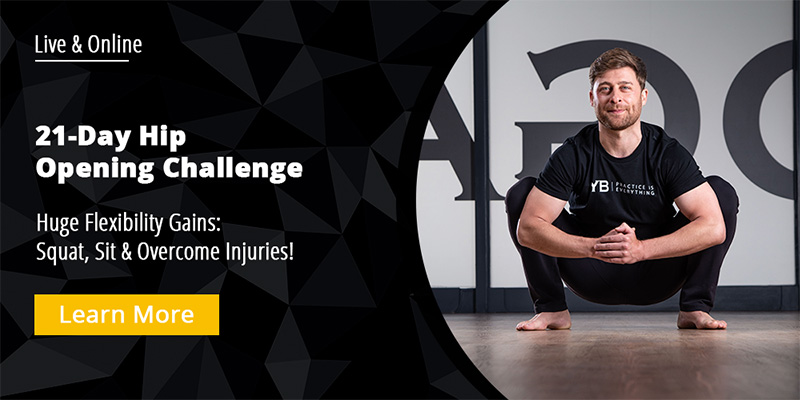Can’t Sit Crossed-Legged? Try These 2 Poses for Tight Hips
My hips used to be so tight that my knees bent up at chest-height when I sat cross-legged on the floor. At age 23, I remember attending a lecture in a dance studio with no chairs and 15 minutes into the talk, I was dripping sweat from the discomfort in my legs. I was that stiff.
How is it possible I’d lost my basic range of motion in my early 20s?
It can happen fast. If you spend a couple of years at an office job, do nothing but cardio machines at the gym, and you don’t stretch at all, you’ll lose your hip mobility in a hurry. Since you’re reading this, it’s probably happened to you. You probably can’t sit comfortably cross-legged either, and you probably notice your tight hips when you try to squat down or lunge.
Your hips are the primary mover of your body so when your range of motion is limited, it can affect your walking, running, and standing postures.
When you’re that stiff, yoga classes are frustrating because so many poses are just too awkward to even attempt, and this is one of the common reasons people sometimes say, “I’m just too stiff for yoga.” Don’t stop going! Yoga classes are great for you, but it’s important to understand that all the really flexible people you know (dancers, yoga teachers, gymnasts) do supplemental flexibility training outside of their core practices.
Flexibility training, or targeted mobility training, is seldom taught publicly. However, privately, it’s practiced by anyone and everyone who really wants to facilitate change. I call this approach Gravity Yoga because all the force comes from gravity as you relax deeply and breathe in a specific pattern that turns off your stretch reflex.
In order to double or even triple your progress, particularly in the hips, keep going to yoga class (this is essential) but take 10-15 minutes each day before bed to practice Gravity Yoga for flexibility. If you’re new to this approach, there are three things to remember.
First, let your body go limp and as relaxed as possible. I call it “wet noodle.” Next, breathe in through your nose to the count of four and out through your mouth for the count of eight. Finally, meet your beat your hold time each round you stretch (start with 2 minutes if you’re unsure).
There are dozens of great Gravity Yoga poses, but I suggest you start with these two classic hip openers.
Butterfly Pose (a.k.a baddha konasana)

- Sit on the floor
- Bend your knees
- Bring the soles of your feet together
- Pull your feet as close to your groin as possible
- Fold forward and place your fingertips on the floor
- Walk your fingertips forward until you can’t fold any further
- Relax everything (legs, back, neck, head, arms)
- Breath in through your nose for a 4 count
- Breath out through your mouth for a 4 count
- Stay here for 3-5 minutes
Blaster Pose

- Take Downward-Facing Dog pose
- Step your right foot between your hands
- Drop your left knee to the floor
- Push your right foot forward until the right ankle is underneath OR in front of the right knee
- Bring both hands onto the floor inside of the leg
- If it’s comfortable, drop down onto your elbows (if not, don’t!)
- Breath in through your nose for a 4 count
- Breath out through your mouth for a 4 count
- Stay here for 3-5 minutes
- Repeat on the other side
The two big muscles that are often blamed for tight hips (though they’re not the only culprits) are the iliacus and the psoas, two important hip flexor muscles referred to collectively as the "iliopsoas."
These tough tissues enable you to lift your leg when lying on your back and lift up your torso in a sit-up. The iliacus originates on the inner bowl of the pelvis, and the psoas (the weird one) originates on the lumbar spine. Both cross the floor of the pelvis, then the outer edges of the pubic bones, and finally insert on the inner upper femur (thighbone).
So you’ve got this big bundle of muscle and connective tissues that starts at your lower back, extends over your pelvis, and finally connects to your legs. If this tissue gets tight and shortened, you lose basic mobility in simple daily activities such as sitting, squatting, lunging, and even back bending.
Years ago, I used to be the guy who sat like Quasimodo, but now I can comfortably take full lotus for an hour or more at a time without changing my posture. Nutrition and breathing play a huge role, but it was primarily these two poses that I used as flexibility training for my hips. So if you've got locked up hips right now, I challenge you to do these two postures each evening for the next four weeks, and you’ll be blown away with the results.
LINKS & LEARNING








